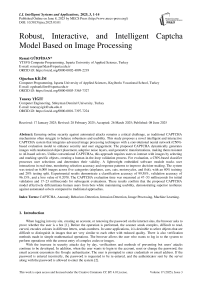Robust, Interactive, and Intelligent Captcha Model Based on Image Processing
Автор: Remzi Gurfidan, Oguzhan KiLiM, Tuncay YigiT
Журнал: International Journal of Intelligent Systems and Applications @ijisa
Статья в выпуске: 3 vol.17, 2025 года.
Бесплатный доступ
Ensuring online security against automated attacks remains a critical challenge, as traditional CAPTCHA mechanisms often struggle to balance robustness and usability. This study proposes a novel intelligent and interactive CAPTCHA system that integrates advanced image processing techniques with a convolutional neural network (CNN)-based evaluation model to enhance security and user engagement. The proposed CAPTCHA dynamically generates images with randomized object placement, adaptive noise layers, and geometric transformations, making them resistant to AI-based solvers. Unlike conventional CAPTCHAs, this approach requires users to interact with images by selecting and marking specific objects, creating a human-in-the-loop validation process. For evaluation, a CNN-based classifier processes user selections and determines their validity. A lightweight embedded software module tracks user interactions in real-time, monitoring selection accuracy and response patterns to improve decision-making. The system was tested on 6,000 images across five categories (airplanes, cars, cats, motorcycles, and fish), with an 80% training and 20% testing split. Experimental results demonstrate a classification accuracy of 99.58%, validation accuracy of 96.15%, and a loss value of 0.2078. The CAPTCHA evaluation time was measured at 47–53 milliseconds for initial validation and 17–23 milliseconds for subsequent evaluations. These results confirm that the proposed CAPTCHA model effectively differentiates human users from bots while maintaining usability, demonstrating superior resilience against automated solvers compared to traditional approaches.
CAPTCHA, Anomaly Behaviors Detection, Intrusion Detection, Image Processing, Machine Learning
Короткий адрес: https://sciup.org/15019778
IDR: 15019778 | DOI: 10.5815/ijisa.2025.03.01


